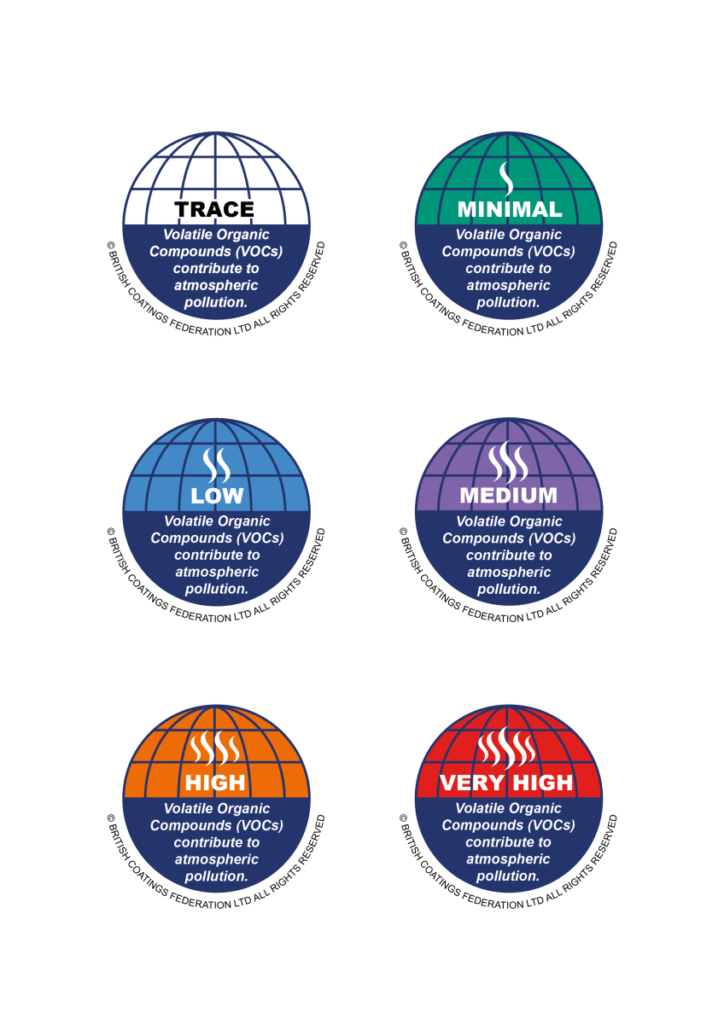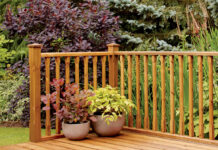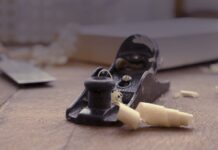Choosing the right product for anything (not just wood preservers) is an important and often daunting process that takes a lot of head scratching and flicking between pages as you look to compare every product possible. There are so many things to consider, from price-point to overall quality – sometimes we want to find that happy medium and sometimes we don’t!
Regularly it results in just walking away thinking ‘I’ll get back to that later’ or doing what I do and googling ‘top 5 wood preservers’ followed by ‘best wood preservers’; well, if you’re anything like me you’ve stumbled onto the right page, as our experts in wood finishing rate some of our most popular wood preservers.
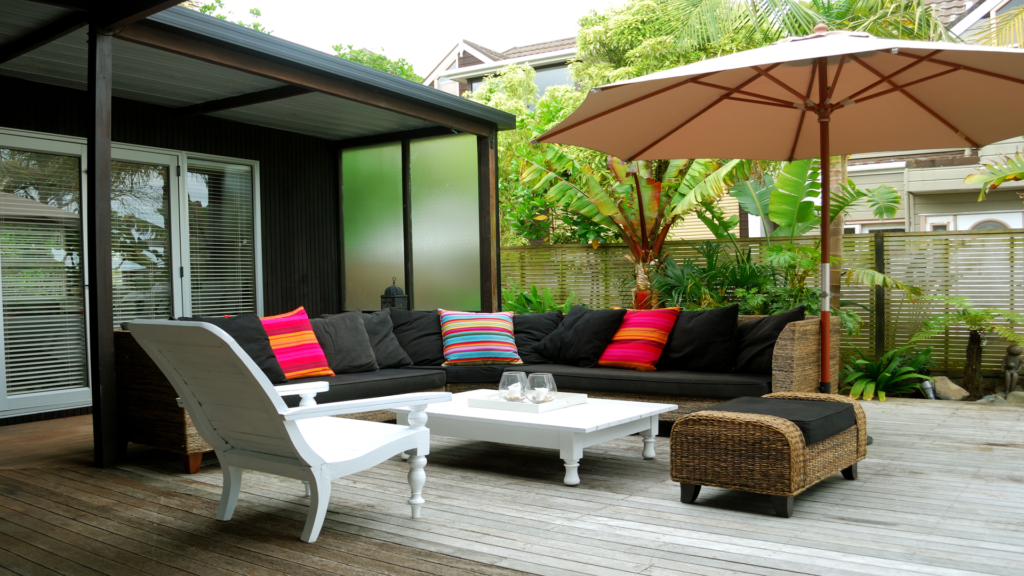
The Favoured Five
These preservers have been carefully rated by our experts, looking at every detail to help guide you to the most suited timber preserver for your needs.
Here’s our top 5 consumer favourites:
- Ronseal Multi-Purpose Wood Treatment
- Cuprinol Wood Preserver Clear
- Ronseal Total Wood Preservative
- Barrettine Premier Universal Preserver
- Barrettine Premier Wood Preserver
So What Actually Are Wood Preservers?
Wood preservers offer protective layering on your timber to prevent the usual suspects that are rot, mildew and parasites from crawling into the fine apertures of your wood. Which often results in timber degradation making it look rather nasty over time.
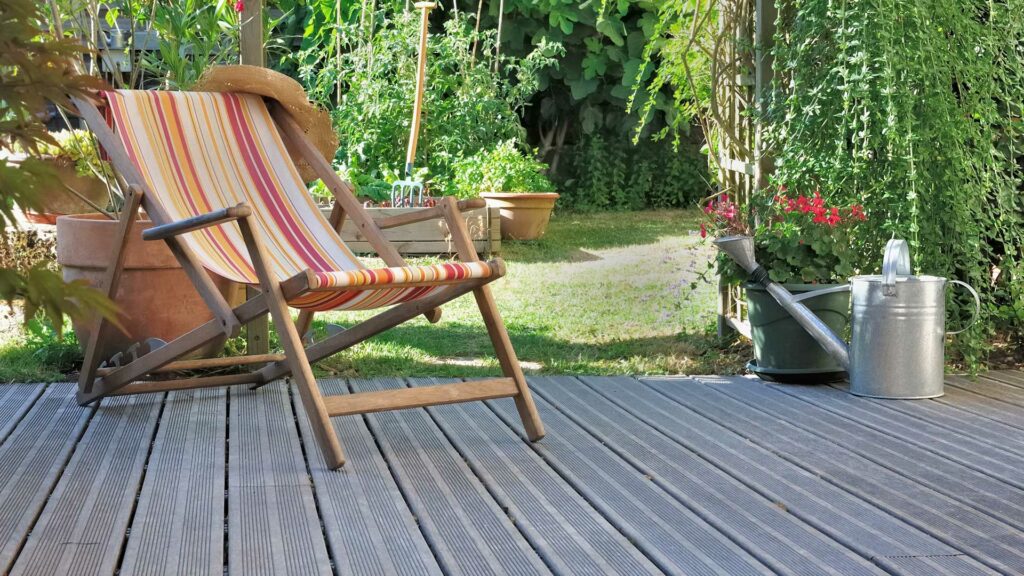
Each wood preserver contains their own unique features though, to help them stand out from one another. For example, some preservers are water-repellent, whereas others contain formulas that prevent blue stain from occurring. Inevitably they all have their unique positives, it’s just a case of what best suits your needs, what top coat you’d like and most importantly, what type of timber it’s being used on.
Wood preservers usually come into play halfway through the timber revival/protection process. Starting with cleaning your wood (if required), followed by your wood preserver and then finishing with that all important top coat – which can be influenced by the preserver you choose.
Your preserving coat is indispensable for untreated timber, as it acts as the sentinel between your wood and the unpleasantries that would usually skulk its way into the timber and eventually your back pocket. To prevent desperately trying to find a pulse in your soon to be dead wood with our wood revivers, taking early steps to protect your timber can go a long way in keeping the woods overall fresh appeal and heartbeat.
A Bit More Expert Information
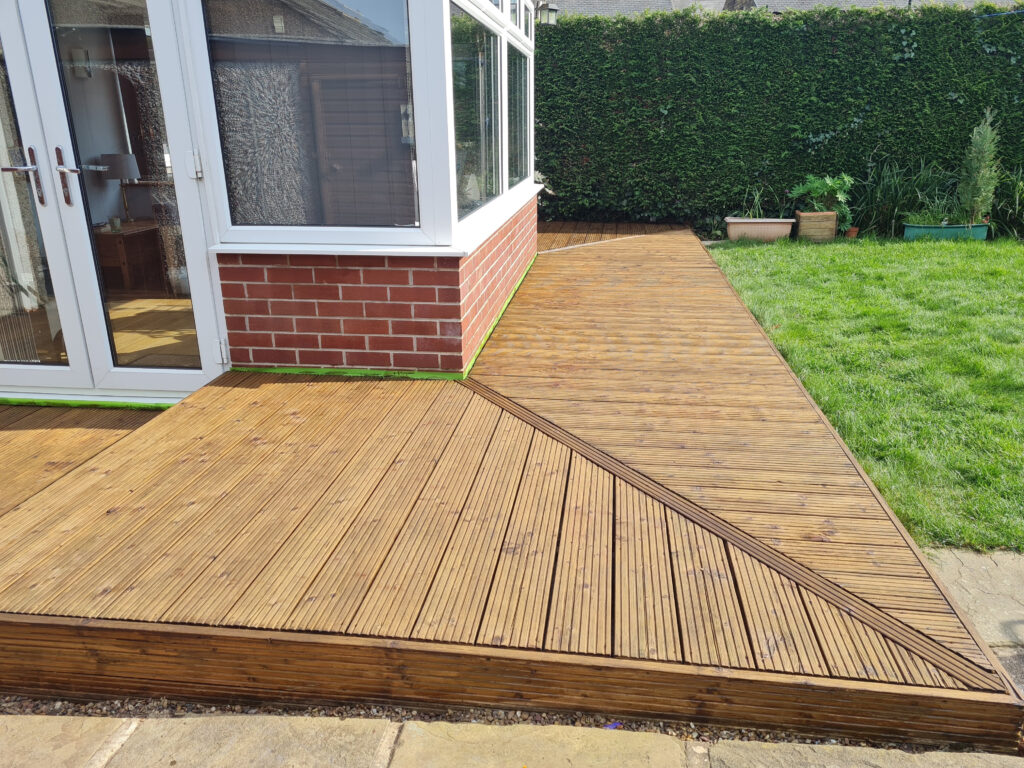
Wood preservers soak deep into the fine grains of the timber, to help maintain the condition of the wood over a longer period of time than usual. The type of wood you have will decide how effective and how deep the preserver can soak into the timber once applied. For example, when you look on the wood preserver product pages, they state they’re for either softwood or hardwood (sometimes both).
This essentially means how tight the wood grain is, the tighter the grain, the harder it is for the preserver to plunge its way deep into your timber. Hence, specially formulated preservers for softwood and the usually rather dense, hardwood. Just to make it even more confusing, there is sometimes softer hardwood and harder softwood, but that’s not too common thankfully!
Timber preservers are also designed to enhance the grain of the wood overall, maintaining the appeal of the wood, rather than covering it like a paint. If you’re looking at maintaining that gorgeous timber like appeal but aren’t sure what top coat would suit your wood best, take a look at wood oils – known for restoring the appearance and natural beauty of wood.
Key Differences Between Wood Preservers
Trying to find the right product is a minefield, you click on each product and they all offer different things, so what do they actually mean? Here are a few of the common features to keep an eye out for.
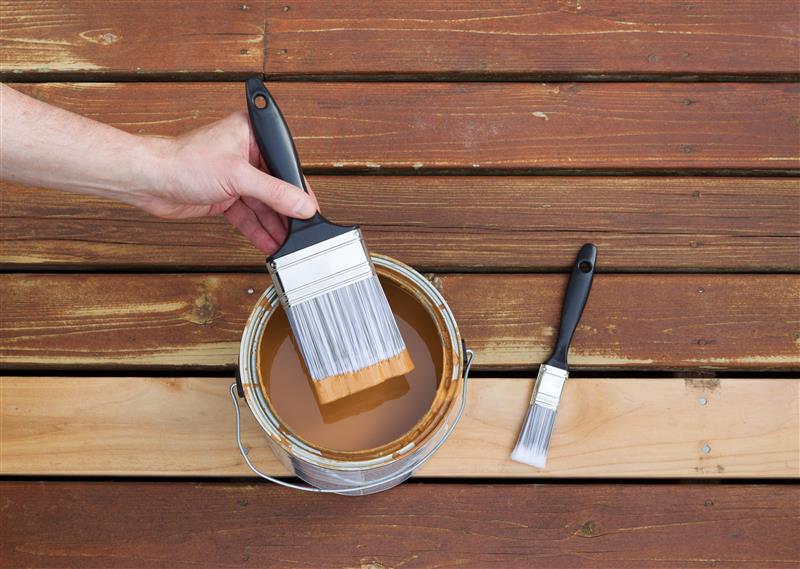
Types of formula
Every preserver will either be made up of one of a water-based formula or a solvent-based formula, both have their pros and cons and choosing one can help funnel your options down by half, giving you more tailored products.
Solvent-based Wood Preservers
First up out of the two formulas is the grizzled solvent-based preserver, this not so eco-friendly version has clocked up plenty of mileage over several decades and is a favourite among seasoned veteran consumers. A couple of things solvent-based formula’s take pride in is that their age-old formula usually has better resistance to the elements and offer greater cohesion than its counterpart.
It’s also more common for solvents to have better finishes with the application also being slightly easier. However, they contain a much greater VOC, making them much more common for exterior use and also take longer to dry. You also have to take more safety precautions when using solvent-based products, especially if you have any health conditions that affect your breathing.
Water-based Wood Preservers
There’s a very good chance you’ll see more and more water-based options now, as the market begins to lean towards a more contemporary, eco-friendly approach as solvent-based options decrease in popularity. So let’s dive into the water-based deep end and see what they’re really all about and if they can hold up against a formula that has over century of authority on the industry.
Water-based preservers typically contain a ‘Low VOC’ and are almost entirely made up of water, meaning they don’t contain many nasty chemicals and can be applied with minimal protective measures in place, while not affecting the air quality much either. For some people with health conditions such as asthma, sticking with a water-based formula will be more suited to you, but unfortunately halves your choices.
This type of formula is also more versatile, with most water-based preservers useable on exterior (fences, sheds, decking and more) and interior surfaces (conservatories), such as Cuprinol’s Wood Preserver Clear. Although it may have a shed slapped on the front of the packaging, it’s perfectly sound to use on interior surfaces as well as your exterior surfaces, like decking. Because the product is water-based it contains a ‘Low VOC’, so it doesn’t have many pungent properties.
Volatile Organic Compounds (VOC)
So after throwing the term VOC around a few times, what actually are volatile organic compounds (VOCs)? They are materials which evaporate from sources such as, car exhausts, cleaning, agents, fabric softeners and of course, solvent-based wood finishing products.
Therefore each wood finishing product is rated between from Trace to Very High. This is classified and regulated by the British Coatings Federation (BCF). The first product be labelled ‘Trace’ was Crown’s Walls and Ceiling Paint in June 2022, it’s that environmentally friendly you could probably eat it (please don’t).
BCF state that VOCs in direct sunlight can react with nitrogen oxides to create ground level ozone and photochemical smog’s, contributing to the pollution of the atmosphere. This would explain the recent shift towards water-based products with their almost guaranteed low VOC, as the environmental impact of humanity is placed under the spotlight more heavily each day with the priority now being protecting the planet rather than destroying it.
Products with a higher VOC are generally more smelly, while also harming animals, insects and plants while drying.
Can Wood Preservers Be Used On Their Own?
Wood Preservers primary purpose is to preserve and protect the timber and is more often than not is finished with a lovely top coat. Despite this, it is actually possible to finish the wood protecting process with just a preserver – providing you use the right one.
The perfect product for this would need to contain wax though, which is water repellent; without this, your wood won’t be protected from the rain and risks being destroyed. Another factor to consider would be the likes of UV resistance, if your surface is going to be exposed to the sun for long periods of time, then you’ll need that feature.
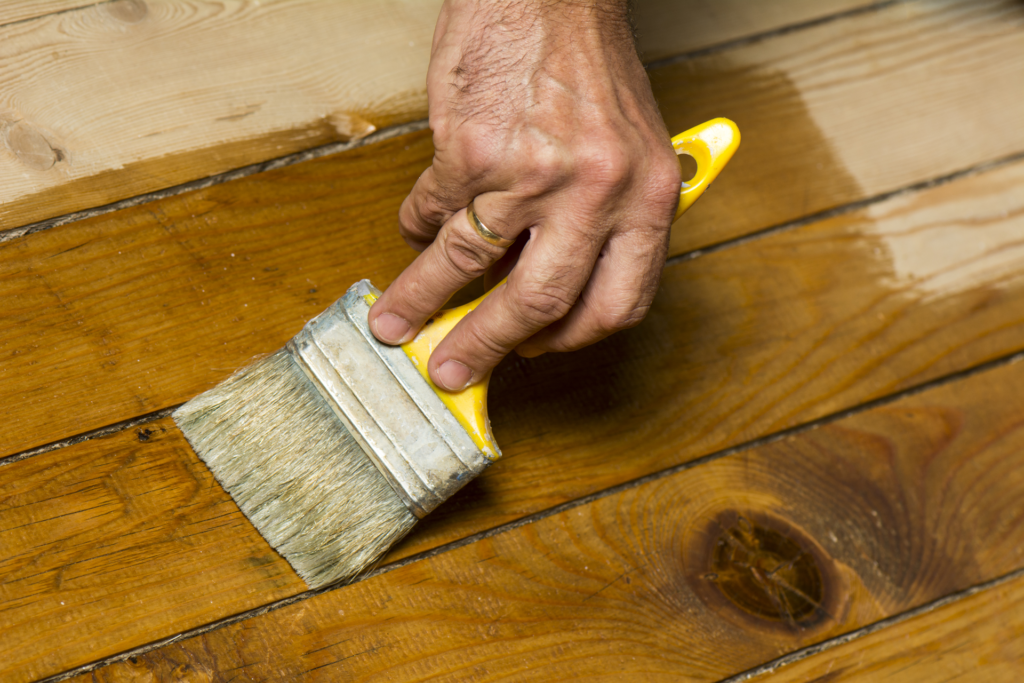
An example of a product that would not be suitable is Ronseal Multi-Purpose Wood Treatment, this is because the formula doesn’t contain wax, nor UV protection. However, the Premier Wood Preserver by Barrettine, would be suitable as it contains both these features.
So if you’re looking to save as much as possible but don’t want to leave your timber to be consumed by Jack Frost and the elements that come to play, you could shortlist this idea (providing you don’t select it in clear otherwise it won’t contain UV resistant properties).
It is possible to just use a preserver on your wooden surface but we’d always recommend using a top coat on exterior surfaces such as decking (due to foot traffic). Just because it’s slightly more pricey at the time of purchase to use an additional top coat, that extra product could go a long way to saving your timber and prevent those drastic wood revival measures in years to come.
The Preservation Process
First of all, it’s important to note that every wood preserver application will be slightly different, reading the back of the tin or looking on the product page description will help guide you. It also depends on the type of timber you have, is it new, previously coated, old, what type of wood is it?
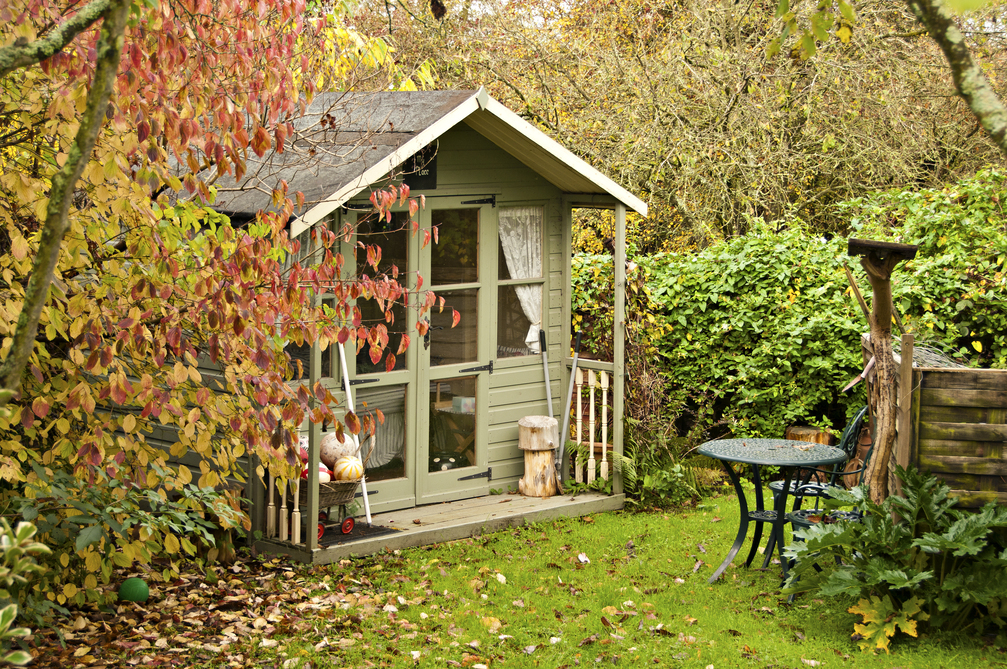
There’s a lot of variables that can affect this process and preparation. For example, if you’re coating new and untreated shed, you should be fine by just giving your shed a clean with a stiff broom before applying your preserver. However if you’re shed is old and has been taken over by nature, you might need the likes of Osmo Wood Reviver Power Gel to give it that kick back to life. If the outbuilding has been previously coated, you’ll need to sand back until the coating has been fully removed or use a paint stripper for example.
That’s all before you can apply your preserver, which hopefully will be as straightforward as dipping your brush into the formula and applying it to your wood, but check for the manufacturers suggestions first as it may differ from product to product. Post preserving, you can apply your stain, oil or paint top coat for a fantastic finish, knowing your timber will have its thick protective coat on for the brutal seasons to come.
5. Ronseal Multi-Purpose Wood Treatment
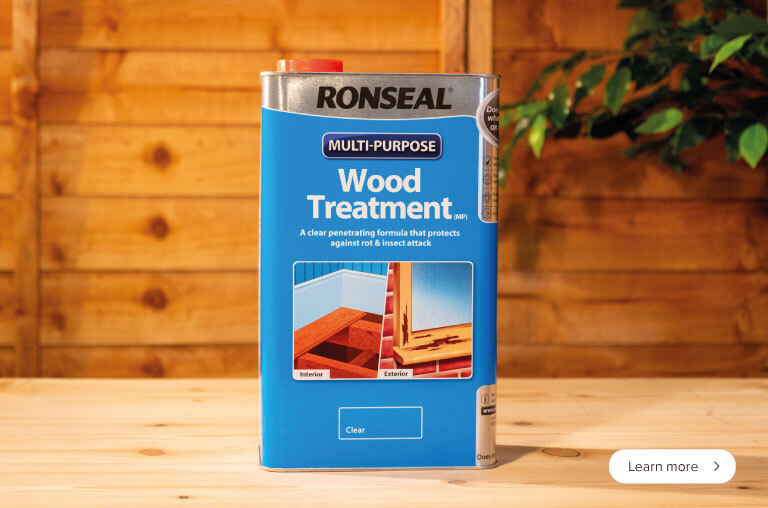
The does what it says on the tin approach from Ronseal certainly remains in fine form with their Multi-Purpose Wood Treatment. It may look basic, but that certainly doesn’t compromise the water-based preservers effectiveness. The best way to summarise this product is actually a customer review from John Ashley, simply giving the product 5 stars and stating “It’s Ronseal”. The legendary name speaks for itself with trusted consumer reliability at a very modest price point, value for money.
The product is unsurprisingly not overly exciting and possibly rather basic, with the product only available in clear and not containing many fancy eye-catching features. Despite that, it does exactly what you want it to do and it does it extremely well – while also useable on a range of surfaces indoors and outdoors.
So, what exactly do you want it to do extremely well? The aim of any preserver is to soak into deep grains of your timber to prevent rot and fungi and this protective layering “soaks deep into the wood to stop future attacks”, if you’re looking for a product that does the basics and does it well, look no further.
The Finer Details
This wood preserver takes the environmentally friendly approach with its water-based formula and therefore ‘Minimal VOC’, which is one of the primary reasons it’s usable indoors too. This feature gives the product a leg-up in terms of versatility, as you can use it indoors which also gives slight reassurance that the product that’s being applied to your timber isn’t a vulgar smelling, chemical disaster that’s being brushed on potentially brand-new fresh wood.
Providing you don’t live on the North Greenland Coast or reside in Qatar you should be fine storing this product between 5°C-40°C, just don’t put it in your freezer – or oven. This multi-purpose wood preserver will prevent wet and dry rot, fungi, larvae and wood boring insect like woodworms. While also being able to top coat this product with a paint, stain or oil, just make sure it’s coloured.
For those who aren’t too sure how to spot woodworm, the insect attack can be recognised by small round holes on the surface of the wood. You can spot a new woodworm attack if the fresh hole has a fine, gritty powder next to the hole.
A drawback to the watery formula is that it does take some time to dry though, with a 24-hour drying time between each coat. While also having a rather unboastful coverage of up to 6m² per litre. But for a little over £31 for 5L and the opportunity to use this in multiple interior and exterior spaces, you are certainly getting value for money.
4. Cuprinol Wood Preserver Clear
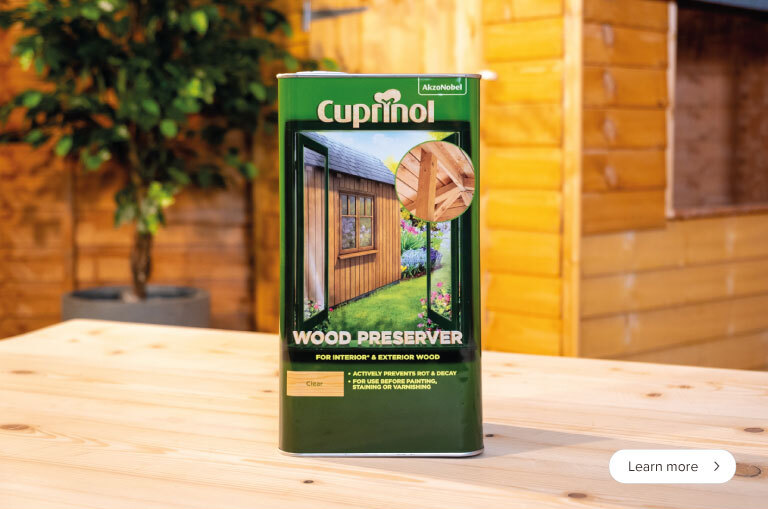
Our most expensive products on this list and by some way is Cuprinol’s Wood Preserver Clear, with the product being over £8 more expensive than the previously compared Multi-Purpose Wood Treatment. So does price translate into quality and what makes this product miss out on a podium spot?
Well, although this wood preserver says it can be used on interior and exterior surfaces, the asterisk next to interior reads that it can be occasionally used with interior wood with risk of condensation. Therefore making it more suitable for exterior surfaces, limiting its supposed versatility straight away, not a great start but still time for redemption.
Unsurprisingly the preserver that can occasionally be used on interior surfaces is therefore water-based with its ‘Low VOC’ sticker isolated on the side of the tin. It has a fairly standard coverage with up to 5m² per litre coverage and a fairly standard 16 hours drying time, nothing too exciting yet.
But this product succeeds at protecting your wood against decay, mould and blue-stain fungi, with the latter being a feature only selected products offer. This timber preserver also only requires 2 coats, whereas most recommend 3. While also giving you the option to apply a coloured top coat as the product is only available in clear.
The Finer Details
Well, there’s not a great deal in all honesty. If there is a does exactly what it says on the tin product in this product guide, it’s actually this Cuprinol preserver, not Ronseal. That’s only a positive for Ronseal though, as their products offer more unique features than Cuprinol’s counterpart. That being said, it’s still a quality preserver with a good drying time and protection; it’s just not the most exciting, but do you need that in a wood preserver that’s going to be top coated?
3. Ronseal Total Clear Wood Preserver
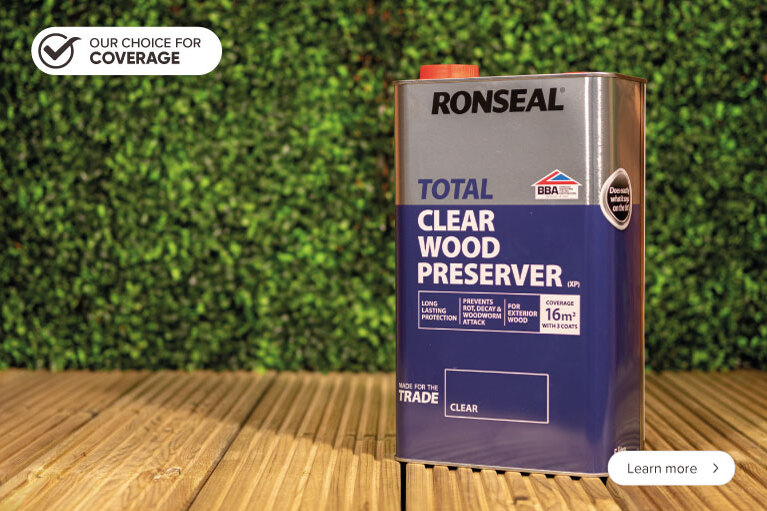
Although there may be 5 colours to choose from, Ronseal strongly advise that you can only apply a top coat to the clear version of this preservative, as the coloured alternative contains wax – which cannot be top coated. Wood Finishes Direct usually say that a wax preservative can still be top coated with an oil, however Ronseal do not recommend this; so to be on the safe side, stick with the clear option and top coat with a colour of your choice for best protection.
So, how does Ronseal Total Clear Wood Preserver compare to other preserving giants and what helps this product stand out? Well, the ‘Very High VOC’ solvent-based preservative offers an impressive up to 8m2 per litre coverage, which is a huge reason as to why this wood preserver earns itself a bronze medal.
However, if you pick yourself up a 5L tin it will say up to 16m2 per litre coverage on the tin, whereas the 2.5L tin says the correct 8m2 per litre (approximately). It looks as if someone who doesn’t understand how coverage per square metre works has doubled the figure because the tin is twice the size. Which isn’t how coverage per square metres works unfortunately, otherwise this would be the best preserver in the business with a gargantuan 16m2 per litre coverage. In this case, it doesn’t do what it says on the tin.
The features this exterior wood preserver offers are reasonably standard but effective, preventing rot, decay, wood discolouring fungi and woodworm infestation with your usual array of application options. While also being perfect for sheds, fences, joists and window frames and lasting 2 years before requiring a top-up. The reviews speak for itself with over 230 5-star reviews and being one of the most popular preservers on our website.
The Finer Details
The fact it’s solvent-based with a ‘Very High VOC’ shouldn’t be a massive issue (unless you have any breathing issues) as you’ll be using this outside. It may be smelly while drying and the odour may attach to some nearby objects, but just give it time and the smell will go away. As always make sure you take the appropriate safety precautions and also keep any animals away from the freshly applied timber preserver and give it the appropriate time to dry.
Unfortunately the wood preserver has quite a lengthy dry time, with it being 24 hours, so if time isn’t your friend this may not be the right product for you. However, Ronseal’s dark blue and silver tin does offer some friendly advice on the back, explaining how to identify wet and dry wot, while also explaining what certain insect attacks look like such as woodworm. An overall handy tin (except the coverage) and a good product from one of the biggest in the industry.
2. Barrettine Premier Universal Preserver
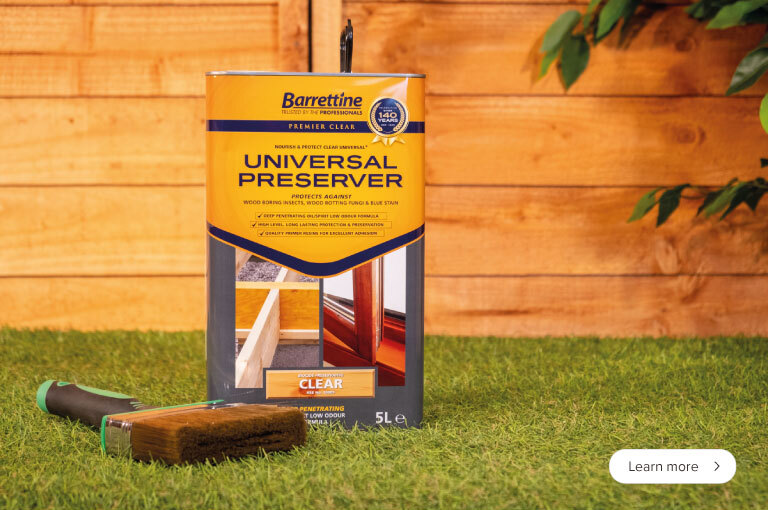
The well-deserved silver medallist goes to Barrettine’s Premier Universal Preserver. Although this product is only available in clear, the companies 140 years trust, reputation and ability to perfect their products gives this wood preserver the edge over many of its competitors.
This product is limited to exterior wood due to it being another solvent-based preserver with a ‘Very High VOC’, it does however deliver fantastic quality. However this product doesn’t contain any wax, therefore not being water-repellent; this does however expand your variety of top coat choices, as you can choose any coloured oil, stain or paint, just don’t pick clear otherwise the two clears combine to form a horrible milky colour.
Barrettine of course favour the age-old solvent formula and shrug off any idea of having the product as a water-based option. In fact, their disapproval of our eco-friendly option is even shown on the side of the tin next to its counterpart demonstrating how ineffective water-based preservers are. A bold move from Barrettine in a market gradually ditching the environmentally harmful options for a greener look.
This product has been labelled to be part of the Nourish & Protect range, essentially meaning that it contains active ingredients effective against wood destroying and discolouring fungi on top of preventing wood boring insects. However, the features don’t quite stop there, as this wood preserver also prevents blue stain and contains a special low odour formulation which attempts to counteract the ‘Very High VOC’ products usually very high odour formula.
The Finer Details
This effective preserver can be easily maintained by applying a fresh coat every 2 years, however if your timber will be experiencing a high volume of foot traffic (such as decking), we suggest you apply a maintenance coat every 12 months.
Although this wood preserver has a fairly decent drying time of 6-12 hours, it does state that it can take up 24 hours in increased humidity, low temperatures and dependent upon the ‘ingredients of some wood species’. So it could dry in 12 hours, unless it’s cold, or warm, or you have woodworm – otherwise you have to wait 24 hours.
The expected coverage on Barrettine’s website is 6.25m2 per litre for this product, however the back of the tin (possibly just due an update) states it offers a conservative 5m2 per litre. At the end of the day, it will vary upon the type of wood you have and the condition it’s in, you may get more and you may get less. Aside from these minor informational discrepancies, this product offers the most flexibility on this list and comfortably deserves a second-place spot.
1. Barrettine Premier Wood Preserver
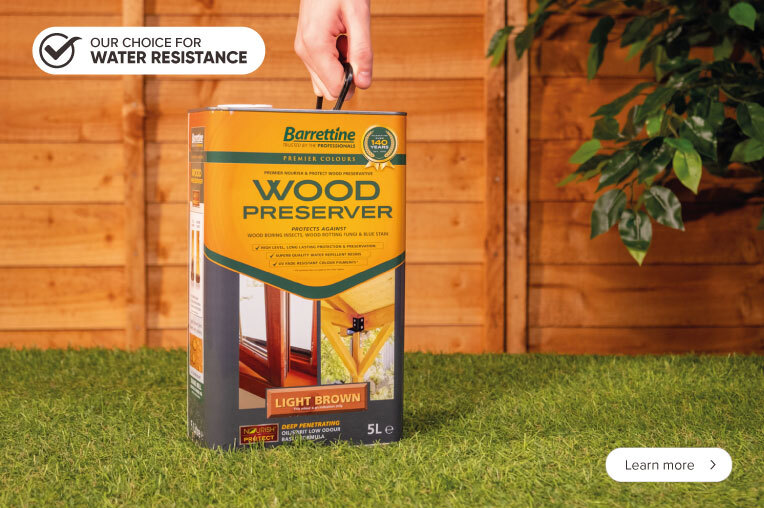
Our triumphant all round wood preserver goes to none other than Barrettine Premier Wood Preserver, providing you choose a coloured version and not the ‘Clear’ option. Its archaic packaging might possibly be this products only downfall, with the company Barrettine specialising in their field for over a century proving they certainly know how to make a preserver perfect for wood – this brand really is holding the key to the secret formula.
Now the reason why you should choose a coloured option rather than the clear is because it contains UV fade resistant pigments, whereas the clear doesn’t surprisingly – giving your timber that extra layer of protection. All Barrettine Premier Wood Preservers contain wax though, making the product water repellent once applied to timber.
This solvent-based and ‘Very High VOC’ formula also contains a low odour additive to help reduce the bad smell when applying the timber preserver. To make this product even more of a clear winner, it has over 2,300 5-star reviews on the product page – impressive.
“Easy to use – low odour and good protection.”
From Mike, a Wood Finishes Direct customer who purchase Barrettine Premier Wood Preserver
The Finer Details
This preserver also offers a fairly conventional coverage of up to 6m2 and unlike Ronseal’s Total Clear Wood Preserver it doesn’t depend on the tin you buy! It also comes with protection against fungi, wood boring insects and blue stain, which for those who aren’t aware is a vague term for various fungi that cause dark staining in some timber.
If you’re seeking ultimate protection, Barrettine suggest 3 coats of this preserver and with a 12-hour drying time, you should be able to get this process done within the span of 2 days, which isn’t common for an exterior solvent preserver that takes 3 coats.
Specialist Tip – Osmo End Grain Sealing Wax
Now, it’s no secret that this isn’t a wood preserver. However, this is great little product we’d recommend adding on the end grains of your wood instead of a preservative. It seals the exposed ends of your timber while repelling any dirt and water.
Osmo’s End Grain Sealing Wax dries to a clear, natural finish, with an added benefit of preventing the wood from swelling and shrinking.
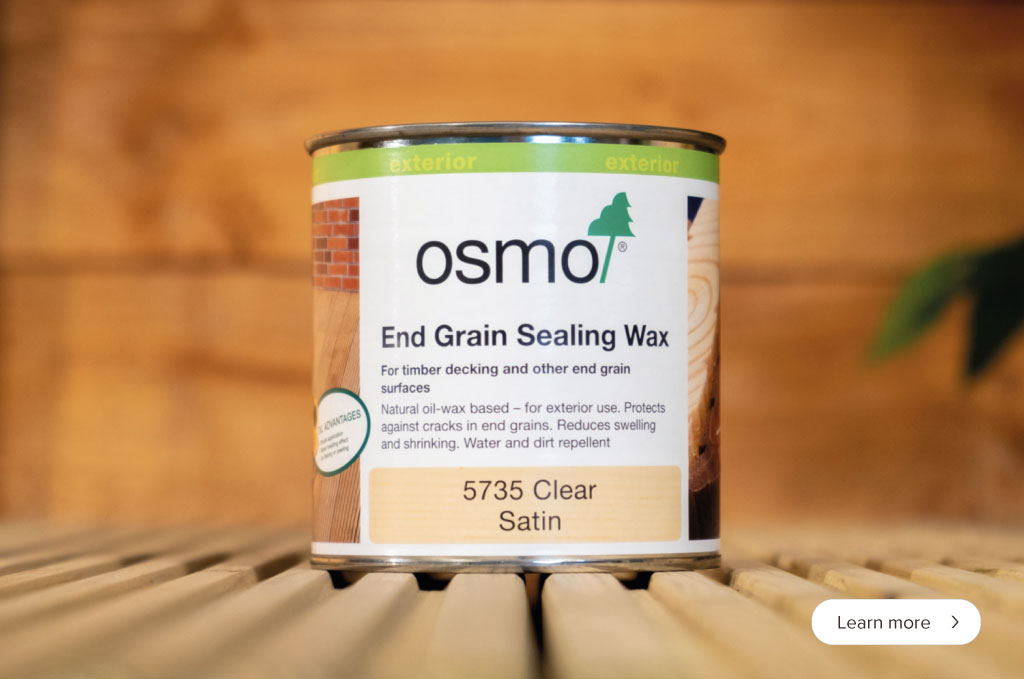
We hope you found this article informative and helpful. If there are any specific products or projects you’d like more information on, please don’t hesitate to contact our experts at wood@finishes.direct or on 01303 213838.


